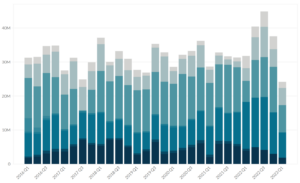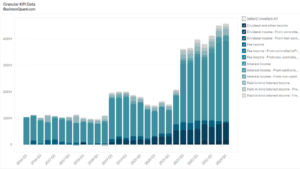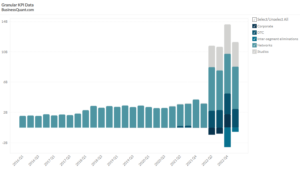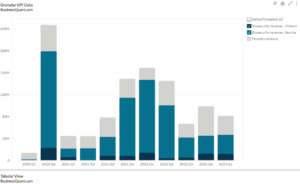
Chipotle’s Average Sales Per Restaurant (2016-2023)
Exclusive Data
You need the Pro Plan to access KPI data
- Full access to the platform
- KPI data & segment financials on US stocks
- Financial data on thousands of stocks
- Download data in xlsx and csv formats
Pro Plan
$49 per month*
60% discount ends in:
.
About
More information
Subscribe to Pro or Enterprise plans to unlock this feature.
Contact the Analyst
Subscribe to Pro or Enterprise plans to unlock this feature.
Become a smarter investor today.
Access KPIs & Segment Financials on US stocks
This statistic highlights Chipotle’s Average Sales Per Restaurant, reported on a quarterly basis from Q1 2016 onwards.
The average restaurant sales refer to the average trailing 12 months beverage and food sales for restaurants in operation for at least 12 full calendar months
Chipotle’s Average Sales Per Restaurants
| Period | Q3 2020 | Q2 2021 | Q3 2021 |
| Average Sales Per Restaurant | $2.20 | $2.50 | $2.50 |
(All figures in millions)
When compared to Q3 2020, which generated $2.2 million, the average revenue per store in Q3 2021 was $2.5 million, indicating a 13.64 percent increase in average revenue per store. In the quarter-on-quarter growth index, the average revenue per store is stagnant with no increase from Q2 2021 to Q3 2021.
The factors that have significantly contributed to the total revenue increase in Q3 2021 were new restaurants openings and comparable restaurant sales increases. In Q1, Q2, Q3, and Q4 2020 all have the same average sales per restaurant of $2.2 million. Whereas in 2021 all quarters had an average sales per restaurant at $2.5 million. The year-on-year is showing growth because Chipotle has been significantly upgrading its capability by digitalizing almost all of its restaurants. Expanding its partnership with third-party delivery services and building more Chipotlanes, which is a drive-through format for the customer to pick up their digital orders. Digital sales account for 46.2% of their total sales in 2020. They have also introduced their Chipotle App and Website which has customer convenience such as unlimited customization, group ordering, and contactless delivery. The digital business is also exposed to risk due to multiple factors, being the delivery fees, they collect from the guest is less than the actual delivery cost which hurts their profitability. In response to this, Chipotle increased menu price affected their sales.
COVID Impact
The COVID pandemic has adversely affected Chipotles’ operations and financial results. In response, they have temporarily closed some restaurants and dining rooms in their restaurants. They are following the guidelines of health officials in determining the appropriate restrictions to put in place for each restaurant. Most of their restaurants opened by December 31, 2020 with some restrictions, to ensure the safety and health of their guests and employees. Chipotle is in constant touch with its distributors to ensure they don’t experience any disruption in their supply chain, which could be foreseen due to COVID, several steps to enhance their robust food safety protocols.
About the company
Chipotle was founded by Steve Ells. The first Chipotle was opened with a single restaurant in Denver, Colorado in 1993. After 25 years, they have devoted themselves to seeking out the best ingredients, raised in respect for farmers, animals, and the environment, which remains at their core commitment to Food with Integrity. They owned and operated 2724 restaurants in the United States, 40 overseas locations, and four non-Chipotle restaurants as of December 31, 2020. Being in a restaurant business they are exposed to the risk of a highly competitive environment – resulting in that if they don’t compete successfully, their business, financial condition, and results of operations will adversely get affected, they also exposed to food safety and food-borne illness concern that may decrease their sales. With increasing dependency on third-party delivery services Chipotle is also exposed to outsourced risk – which indicates if the delivery companies don’t perform as per the standard, it will affect the Chipotle brand directly adversely affecting the long-term sales, operation, and financial position of the company.
Did you like Chipotle’s Average Sales Per Restaurant statistic?
Access Key Performance Indicator (KPI) data points and segment financials on US stocks, with Business Quant.
You can get started here.
More data on US Stocks

Our Plans
Always know what you’ll pay. No hidden costs or surprises.
- Annual
- Monthly
60% discount till April 30
Pro
For serious investing
-
Company KPI data Access segment financials, non-GAAP metrics and KPI data from presentations and filings. Examples include financials by segment / region / product category, AT&T's broadband subscriber trends, Tesla's deliveries by model and lots more.
-
Stock research tools Features include : stock screener, stock comparison, industry financials, stock warnings, advanced charting tools, timeseries tables, scatter charts, financial statements, stock reports, SEC filings, stock ratings, institutional and insider ownership data. There are 200+ financial items and ratios on thousands of US stocks.
-
Industry data & tools Access premium operating data on 40+ industries. Examples include market share, smartphone shipments by vendor, subscribers by wireless carrier, historical gold production. There are 20,000+ such statistics.
Enterprise
For tailored workflows
-
All of Pro plan Get unfettered access to all our dashboards and dossiers.
-
Custom built features Get tailored dashboards built specially for you , based on your set of requirements, to simplify your research workflow.
-
Admin billing Back-end documentation support and multi-seat licensing.
* Billed annually, local taxes extra.
60% discount on Annual plan
Pro
For serious investing
-
Company KPI data Access segment financials, non-GAAP metrics and KPI data from presentations and filings. Examples include financials by segment / region / product category, AT&T's broadband subscriber trends, Tesla's deliveries by model and lots more.
-
Stock research tools Features include : stock screener, stock comparison, industry financials, stock warnings, advanced charting tools, timeseries tables, scatter charts, financial statements, stock reports, SEC filings, stock ratings, institutional and insider ownership data. There are 200+ financial items and ratios on thousands of US stocks.
-
Industry data & tools Access premium operating data on 40+ industries. Examples include market share, smartphone shipments by vendor, subscribers by wireless carrier, historical gold production. There are 20,000+ such statistics.
Enterprise
For tailored workflows
-
All of Pro plan Get unfettered access to all our features.
-
Custom built features Get tailored dashboards built specially for you , based on your set of requirements, to simplify your research workflow.
-
Admin billing Back-end documentation support and multi-seat licensing.
* Local taxes extra.






